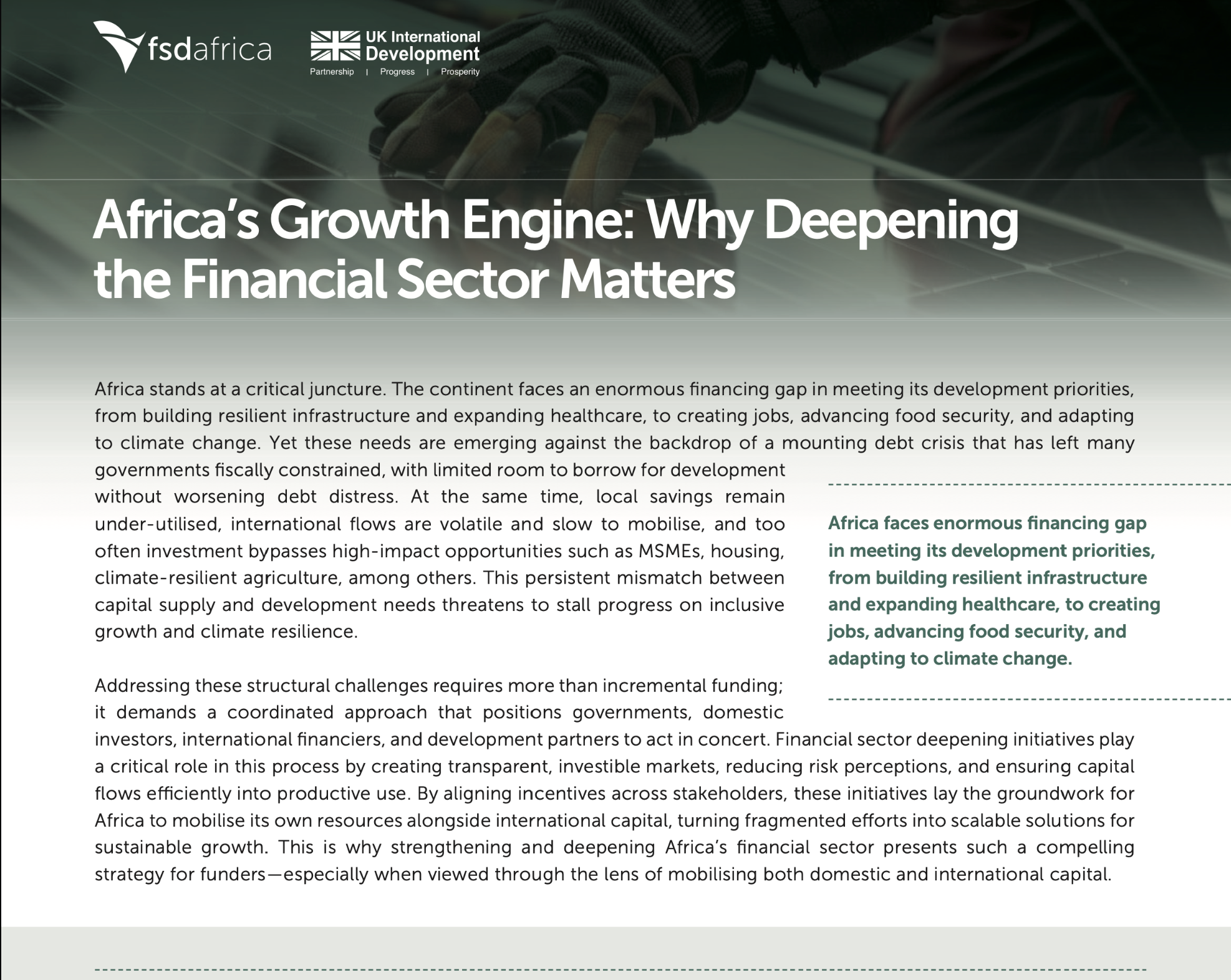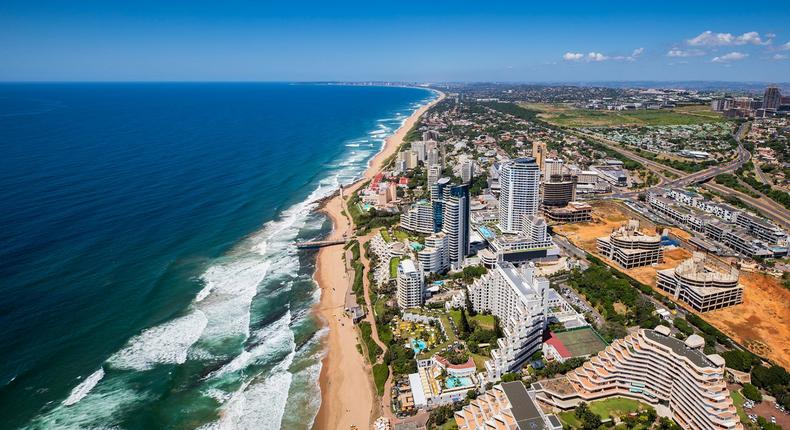This white paper, the first in a series tackling key questions for donors and market actors interested in financial sector development, sets out four key reasons why strengthening and deepening Africa’s financial sector matters for the continent’s sustainable growth, and why investing in it is good value for money.
Campaign: Climate
The Tanzania Early-Stage Climate Adaptation Venture Landscape Report, conducted by FSD Africa and EIT Climate-KIC, offers a comprehensive analysis of the financing ecosystem for climate adaptation initiatives in Tanzania. The report highlights the nascent but growing startup ecosystem, underscoring the challenges faced by early-stage ventures, such as limited access to tailored financing options and a lack of investment readiness. It also identifies agriculture and energy as the dominant sectors, with innovative startups addressing climate challenges through AI, digital marketplaces, and sustainable technologies. However, bureaucratic inefficiencies and stringent financial regulations remain key barriers to scaling these ventures.
To foster a thriving ecosystem, the report outlines strategic interventions, including the expansion of incubators, enhanced investment readiness programmes, and the promotion of flexible debt financing solutions. It emphasises the importance of fostering stronger linkages between businesses, investors, and accelerators, while advocating for policy reforms to create a more conducive environment for climate adaptation initiatives. This roadmap aims to build a robust pipeline of investable businesses and attract diverse funding sources to scale impactful solutions for climate resilience in Tanzania.
For too long, the economic orthodoxy guiding businesses — as well as the central banks and regulators overseeing them — has taken scant interest in the natural capital that underpins so much economic activity. For decades, many have invested their faith in the power of the markets to inexorably protect value and the assets which guarantee it.
However, change is afoot. What’s more, it’s a seismic shift led by Africa.
Natural systems account for 50% of global economic value generation and few can now doubt that natural assets are inextricably linked to economic health. This emerging consensus, that acknowledges nature’s status as an engine of economic growth, could not come sooner.
The world’s stock of natural assets is declining at a disturbing rate. Just one of many depressing examples is the fate of the world’s coral reef habitats, which constitute the biodiversity engine of our oceans and illustrates the scale of the burgeoning crisis: Oceanpanel.org studies indicate that climate change — and the accompanying acidification of the oceans — will destroy 72% of coral reef habitats by the end of this century. That does not account for the toll of overfishing and pollution, which will cause further damage.
Africa’s leadership in integrating nature-related risk frameworks derives from the knowledge that the continent’s share of damage will be disproportionate. Why? The continent claims a quarter of the world’s natural capital, 65% of the world’s arable land, 25% of the world’s global biodiversity and 20% of global tropical rainforest area. Indeed, while the global decline in Biodiversity Intactness Index score amounted to 2.7% between 1970 and 2014, Africa witnessed a decline of 4.2% in its score.
A roadmap for real change
From an environmental standpoint, these statistics suggest a tragedy of unparalleled scale. But economically speaking, the risk is nothing short of existential.
The African Development Bank estimates that natural capital accounts for between 30% and 50% of the total wealth of African countries; and in sub-Saharan Africa, more than 70% of people depend on forests and woodlands for their livelihoods. From agriculture to fishing and tourism, Africa’s economic future is in real, imminent jeopardy.
Establishing nature as a key area of risk management marks a vital first step, from which can follow a roadmap to real, tangible change.
In December, world leaders convened in Dubai for the COP28 climate change conference, which has elevated nature as one of its central themes — an important move since COP15’s adoption of the Kunming-Montreal Global Biodiversity Framework (GBF). The framework contains vital targets for achievement by 2030, including the conservation of at least 30% of land, sea and inland waters, as well as restoration amounting to 30% of degraded ecosystems, and a $500bn annual reduction in subsidies that promote biodiversity loss.
Pre-empting the sceptics, it’s of course true that target-setting and ambitious rhetoric do not themselves address the challenge we face. But establishing nature as a key area of risk management —
requiring sober, active regulatory intervention — marks a vital first step, from which can follow a roadmap to real, tangible change.
Though indispensable, COP is not the only forum for change. The Taskforce on Nature-related Financial Disclosures (TNFD) marks an important shift in how businesses account for their non-financial liabilities, as well as their impact on the surrounding ecology. Its recommendations (already launched in Kenya and South Africa) have convinced much of the private sector that environmental performance is as material as revenues and market share — a shift inconceivable only a decade ago.
In Africa, both the African Natural Capital Alliance (ANCA)-run pilot, as well as the work of TNFD consultation groups in Kenya and South Africa, are revealing significant private sector interest in early adoption of nature-related disclosures. But what about those who supervise the private sector and set the economic ‘mood’?
We’re seeing a real shift in African voices leading the way for change. Many now recognise the need for African private and public sector awareness and capability-building for the successful integration of not only future nature-related risk frameworks and standards, but also broader nature-related capabilities. Without engagement on these topics, there is a danger of creating additional transition risks and barriers to investment in the African continent.
Asserting the centrality of nature
Arising from the 2017 ‘One Planet’ summit in Paris, the Network of Central Banks and Supervisors for Greening the Financial System (NGFS) has undertaken impressive work orienting the financial system to manage risks and mobilise capital for green investments. With 129 members hailing from every major region of the world, there is a real appetite among regulators for guidance on natural assets and capital. Crucially, African regulators have led the development and implementation of these recommendations, and from Morocco to Nigeria, Kenya to Ghana and South Africa, financial authorities are asserting the centrality of nature in national economies and economic strategies.
Both the TNFD and the NGFS have established frameworks and regulatory best practices to encourage natural capital’s incorporation into economic thinking and strategy. However, many continue to doubt the real, material economic benefits nature affords.
An economic case for natural conservation and restoration could invoke almost limitless examples, but mangrove restoration represents a particularly striking case in point. As well as being almost peerless havens for biodiversity, mangroves turbo-charge local economies and, indirectly, the broader global economy. For example, a staggering 80% of world fishing catches depend in some way on mangrove forests.
Beyond fishing and carbon sequestration, mangroves also matter to world business because they insulate coastal economies from the ravages of erosion, flooding, storms and tsunamis. They are, in essence, nature’s first line of defence.
Again, the coastal defences provided by mangroves benefit more than those inhabiting coastal regions — indeed, they are of vital importance to any business with direct or indirect connections to suppliers, customers, or services in major world economies such as India, Brazil, the Philippines, Ivory Coast, Mexico, China, Vietnam and Bangladesh. The ability of these economies to withstand the growing threat of rising sea levels will prove vital for the world’s supply chains and those companies hoping to reach consumers in much of the Global South — where a growing proportion of the world’s future customers will live and work.
Channelling capital into projects, such as those undertaken by the Global Mangrove Alliance, and ensuring regulation deters coastal depletion and deforestation, ranks as one of many nature-related challenges financial authorities will face over the coming decade. Failure to do so will unleash human and economic damage to global growth on a scale which will easily outstrip the disruption wreaked by the COVID-19 pandemic.
Few businesses are insulated from these risks
It’s worth restating the global implications of this threat — few, if any, businesses on Earth can reassure themselves that they are insulated from these risks. A survey of these threats makes for depressing reading. However, there’s another story to tell — one in which natural capital underwrites sustainable development and becomes a cornerstone of rapid economic growth.
With 75% of African countries having sea access, a sustainable blue economy promises significant long-term wealth if well-managed. The Green Growth Knowledge Platform, for example, found that every US dollar invested in marine protected areas in Senegal and Tanzania generated more than $5000 in economic value. A carefully managed process of extraction and processing could well endow the continent, which hosts 30% of the world’s mineral reserves, with economic firepower previously unthinkable.
Moreover, if financial regulators are able to construct a credible global market for carbon and biodiversity credits, Africa’s vast natural wealth can be, simultaneously preserved and monetised.
It’s a truth most MBAs cover in their first lesson, but one that we seem to have collectively forgotten: strong risk management is impossible without real transparency and honesty.
It’s time, therefore, to think about nature and its preservation not as a fluffy add-on or stamp of corporate virtue, but as a core business consideration — as material as accountancy rules or corporate governance regulations. The shift in attitude must be stark. Just as regulation protects business, investors and the public from practices such as fraud, which ultimately destroy value, so must financial authorities work to protect that which underpins all human activity: nature.
On December 5, ANCA — whose mission is to catalyse nature- positive African economies — hosted a session at COP28’s Blue Zone to discuss the results of a pioneering, first-of-its-kind stress test of nature risks across five African financial systems. We know the threat to Africa’s natural capital is looming, but it’s key that we establish just how exposed economies are, and in what ways. Only then can central banks and regulators intervene to ensure the strength of African financial systems, and the resilience of the environment and ecology which underpins them. Action is needed — and for this to be effective, clarity on where and how is key.
Africa is sitting on a green gold mine — but its institutions must work to protect the inheritance of Africans, both living and as yet unborn.
Dorothy Maseke is Africa lead, nature finance and Taskforce for Nature–related Financial Disclosures at FSD Africa, and head of the African Natural Capital Alliance.
A recent report by The African Natural Capital Alliance (ANCA) during their co-session with FSD Africa at COP28 reveals critical insights into the exposure of African countries to nature-related risks.
- 62% of African GDP is dependent on nature services, with 70% of sub-Saharan African communities relying on forests and woodlands for their livelihoods.
- The reliance on nature services poses significant risks for many African countries due to climate change, deforestation, and degradation of ecosystems.
- The report urges the African financial sector to foster sustainable financial practices and take proactive measures to address these risks.
According to the report “Nature Stress Testing: Exposure to Nature-Related Risks Across Africa”, 62% of African GDP is dependent on nature services, and 70% of communities in Sub-Saharan Africa rely on forests and woodlands for their livelihoods.
The Dependence on Nature Services in African Countries
The report stated that the reliance on nature services poses significant risks for many African countries due to climate change, deforestation, and degradation of ecosystems. In addition, the report’s findings hold significant implications for financial regulators and private financial institutions across the continent, as their financial systems and portfolios are likely exposed to similar levels of risk.
With the African financial sector gaining momentum, the report emphasised a growing need for proactive measures to address nature-related risks and opportunities. The stress test explores different nature transition pathways and their potential impact on the profits of businesses across these economies. It identifies how these pathways could create knock-on risks for the financial sector, emphasising the need for proactive measures.
The report specifically assesses the exposure of the African banking sector to nature-related risks, offering consolidated findings from a nature stress testing exercise conducted in five African countries [Ghana, Mauritius, Morocco, Rwanda and Zambia]. These findings hold significant implications for financial regulators and private financial institutions across the continent, as their financial systems and portfolios are likely exposed to similar levels of risk.
According to the report, If current policies and business practices persist, some countries may face substantial nature-related physical risks, especially in sectors like agriculture. The World Economic Forum also estimates that $44 trillion of global economic value creation intrinsically relies upon while also degrading natural capital, with $195 billion being the estimated yearly loss of natural capital in Africa.
To address these risks, the report urges the African financial sector to take steps to foster sustainable financial practices. So far, 16 private financial institutions across seven countries are currently piloting or in the process of piloting the Taskforce for Nature-related Financial Disclosures (TNFD) framework.
The ANCA report provides valuable insights into the challenges and opportunities faced by African economies as they grapple with the impact of nature-related risks. By working together, financial regulators, private financial institutions, and other stakeholders can take proactive measures to address these risks and foster nature-positive African economies.
Read original article
A new nature-based voluntary carbon market certifier has released its standard and reforestation methodology, it announced Wednesday.
Read original article
Financial instruments supporting mangroves and forestry are under consideration by members of the African Natural Capital Allliance (ANCA), an executive at the organisation has said.
ANCA is in conversation with financial institutions looking to create innovative instruments that support mangroves and forests, according to Dorothy Maseke, head of ANCA’s secretariat.
“ANCA and FSD Africa are looking towards supporting a number of specialised financial instruments in mangroves and forestry,” Maseke told Carbon Pulse.
These could combine elements of bonds, guarantees, and insurance, she said. Established in 2022 by non-profit FSD Africa, ANCA is an African-led initiative whose members – including the likes of Standard Chartered, KCB, and Equity Bank – together manage assets of $390 billion.
Conservation bonds could be a key area of expansion for ANCA members, Maseke said.
“The discussions on opportunities are real. We are doing a lot in terms of connecting our partners, to support them on this journey, because many are interested. They just don’t know where to start,” Maseke said.
Regulation needs to change to support conservation-related bonds as “capital market structures in Africa do not necessarily support them,” she said.
“When the regulator supports capital market structures that will support this kind of investment, then it gives financial institutions, investors, and private equity the confidence to put their money on the table,” she said.
“It also enables fund managers or advisory firms to actually develop these bonds. Those are some of the things that ANCA will be pushing for.”
The only conservation-related bond on the continent to have been issued so far was the World Bank’s ‘rhino bond’, a $150 million issuance in 2022 in support of black rhinos in South Africa.
AFRICAN BIODIVERSITY CREDITS?
Development agencies and small project owners are driving discussion on the topic of biodiversity credits in Africa, another novel way of financing nature, Maseke said.
“Those developers who for years have been working on small projects, now all of a sudden are starting to pay attention,” she said.
“You may find some financial institutions who decide to develop the [biodiversity] credits market. Some may want to put up a biodiversity credits exchange.”
When governments drawing up nature strategies turn to private financing, they will eventually begin to work with these smaller actors on biodiversity credits, she predicted. “At some point, they’re going to converge. In some countries, they’re already converging.”
“Strong discussions” about biodiversity credits from market actors in countries including Rwanda, Ghana, Kenya, and nations around the Congo Basin are underway, she said.
“Kenya wants to go into the green economy and the bioeconomy is a key part of that. There’s a whole discussion of bioeconomies from biodiversity-rich African nations. Building a bioeconomy is the next frontier.”
However, lessons on biodiversity credits have been learned from the carbon credits market, she said. “It’s still a developing concept. It’s also coming on the backdrop of very negative press from the carbon credit side.”
“There’s still a lot of research that needs to be done in terms of, is the African market ready to go fully into it? That needs to be done fast.”
One advantage a voluntary biodiversity credits market would have over its carbon equivalent is that the former already has Indigenous Peoples and local communities at the centre, she said.
Read original article
Nairobi, 25 July 2023: A new report from the collaborative forum of African financial institutions the African Natural Capital Alliance (ANCA) and management consulting firm Oliver Wyman has underlined the growing importance of African regulators acting on nature-related risks in line with their mandate of maintaining financial stability.
The report “Improving the transparency of nature-related risks in Africa: the emerging regulatory agenda”, outlines how financial sector stakeholders, including regulators, are increasingly recognising that the depletion of nature poses risks to financial and economic stability.
The report makes clear that the issue is a particularly urgent one for sub-Saharan Africa as its economies are disproportionately dependent on nature. For instance, over 70% of people living in the region are dependent on forests and woodlands for their livelihoods, compared to about half of the total world’s GDP generated in industries that depend on nature. The rate at which nature in Africa is being lost also exceeds the global average. For example, Africa’s Biodiversity Intactness Index (BII) score – which measures the number and abundance of species on land – declined by 4.2% between 1970 and 2014, considerably higher than the global BII score decline of 2.7% over the same period.
In East Africa alone, failure to protect natural capital as a whole (including its stocks of soil, air, water, and all living things, which underpin the region’s economy and human well-being) would result in an economic loss of more than $11.3 billion a year, according to an assessment commissioned in 2021 by USAid.
Dorothy Maseke, the Nature Lead at FSD Africa and ANCA, says: “Enhanced transparency of nature-related risks is fundamental to managing them effectively. This is the case for individual financial institutions, which need visibility of the nature-related risks in their lending, underwriting, and investment portfolios. And it is also the case for regulators, so that they can identify nature-related risk concentrations for regulated entities and assess whether they are being managed effectively.”
African regulators embracing this complexity is so important, she adds, because the continent is disproportionately exposed to nature-related risks.
Sandra Villars, senior advisor at Oliver Wyman, says: “The Global Biodiversity Framework (GBF), which was adopted in December 2022 by 188 governments across the world, aims to address biodiversity loss, restore ecosystems, and protect indigenous rights. This landmark agreement prompts governments to introduce policies to manage nature loss, which will lead to regulators having to act, and highlights the opportunities for regulators to do so proactively.
African regulators could thus benefit from engaging with this new agenda early and being at the forefront of integrating nature into their regulatory regimes.”
As summarised in the report, there are four simple steps regulators can take as part of a nature-related disclosure roadmap while policy frameworks are being finalised in their jurisdictions:
- Engage with finance and environment ministries to align their regulatory approach with
- government’s policy agenda on nature
- Assess internal capacity and act on gaps
- Assess the capacity for action among regulated entities
- Engage in voluntary nature networks such as the Sustainable Insurance Forum (SIF), the Network for Greening the Financial System (NGFS), the African Natural Capital Alliance (ANCA), and the Task Force on Nature-Related Financial Disclosures (TNFD)
In this edition of the African Business podcast we speak to Elizabeth Maruma Mrema about her role as co-chair at the Taskforce for Nature-related Financial Disclosures. Maruma Mrema is also the United Nations Assistant Secretary General and the Deputy Director of the United Nations Environment Programme. She is one of Time magazine’s Most Influential People for 2023 – having been a key figure at the Nature COP 15 in Montreal spearheading a groundbreaking agreement on biodiversity protection.
In this episode she tells us how the Taskforce on Nature-related Financial Disclosures (TNFD) was established to develop a risk management and disclosure framework for organisations, aiming to shift global financial flows towards nature-positive outcomes.
As climate change and nature are interconnected, an integrated approach has become necessary to effectively address these challenges. Maruma Mrema tells us about the significance of integrating nature-related disclosures within climate-related reporting and the role of corporate disclosures in promoting transparency and accountability.
The TNFD also complements the Task Force on Climate-related Financial Disclosures (TCFD). By integrating nature-related information into financial decision-making processes, businesses can mitigate risks, identify sustainable opportunities, and contribute to nature conservation. The TNFD has closely aligned its recommendations with the TCFD to promote consistency and facilitate the adoption of an integrated climate-nature disclosure framework.
We also look ahead to the launch of the TNFD framework in September in New York and to Cop28 in December in the UAE.
Read an excerpt from the interview in IC Intelligence Insights 09: Nature and Climte Redux
Credits
Host and executive producer: Dr Desné Masie
Co-producer: Peter Doerrie
Digital Editor: Charles Dietz
Design: Jason Venkatasamy
Music: Corporate Uplifting Chill by MusicLFiles
Licence: http://creativecommons.org/licenses/by/4.0/
Read original article









